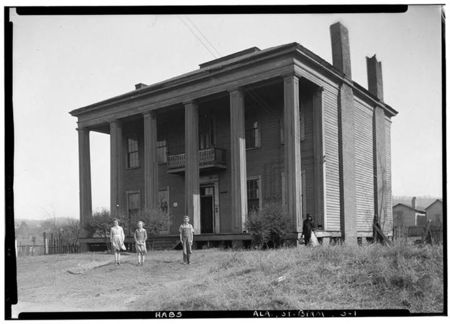Benjamin Worthington residence
The Benjamin Worthington residence, also called the B. P. Worthington Plantation, was an 800-acre farmstead in the eastern section of Birmingham, in present day Lakeview. It was cleared and farmed by Benjamin Worthington, who built an eight-room, two-story wood-framed house near the center of his holdings in 1858.
Bricks for the foundation were made on-site by Worthington's slaves. Window glass ordered from Louisville, Kentucky was never delivered, owing, it was said, to the growing disagreements between the North and South in the late 1850s. A system of bored-out logs conveyed water from "Spring Hollow" (present day Rushton Park).
Worthington, whose attempt to move his family to South America after the Civil War came to naught, was one of the founding directors of the Elyton Land Company. On December 8, 1870 he conveyed all but the two acres of his property surrounding the house to the Josiah Morris as trustee of the company. The plat of Birmingham drawn up by William Barker indicated the proposed subdivision of the Worthington plantation into streets and blocks, with the house sitting squarely within the right-of-way of 31st Street between Avenue F and Avenue G. When the area was surveyed for improvement, that block of 31st street remained closed.
On July 22, 1872 the Worthingtons executed a contract for the sale of their remaining two-acre parcel, subject to the condition that they be allowed to remain resident in the house until such time as the company proposed to claim the street right-of-way for improvement, when they would pay him the assessed value of the improvements. In the end, the company deferred improving on the block until after Worthington's death in 1884.
In his will, Benjamin Worthington left the house to his widow, Caroline. She, in turn, left it to her three daughters at her death in May 1889. Two of the heiresses, Virginia and Mary conveyed their interest in the property to the remaining sister, Ella, in April 1905. She maintained possession, thereafter, until in 1916 the City of Birmingham filed a bill in equity in the Birmingham Municipal Court, seeking to require her to remove the buildings and fences from the street right-of-way as, in the city's opinion, they represented a public nuisance. She appeared in court and won a dismissal of the bill on the grounds that the city did not offer payment as stipulated in Worthington's contract. The municipal court's decision was upheld on appeal to the Supreme Court of Alabama.
Ella, the wife of J. F. Graham, remained in the house until her death in 1947, after which it was inherited by her grandson, Henry Graham Sims. Sims filed a bill seeking to either clear his title to the property, or put up a lien for the value of the improvements on the property against any claim by the city. That case also went before the State Supreme Court, in 1950. Their ruling affirmed the terms of the original contract, meaning that the city continued to hold the right to acquire the right-of-way and must pay to Worthington's heirs the contractually-agreed settlement at that time.
The city promptly assessed the value of the Worthington residence, along with a few cottages and outbuildings, at $150. That amount was unsuccessfully challenged in court by another descendent, Henry Upson Sims. In 1953 the City paid the $150 and took ownership of the former homestead. They immediately sold the house to the Burgin House Moving Company in exchange for their removing it. Demolition began immediately.
References
- Browne, Catherine Greene (2007) History of Avondale. Birmingham: A. H. Cather Publishing Co.
